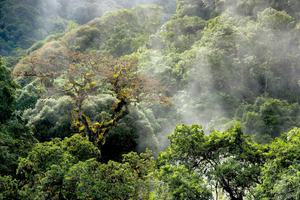An emperor penguin breeding pair and their chick. Christopher Michel
Antarctica’s second-largest breeding colony of emperor penguins, located in the Weddell Sea, has experienced “catastrophic breeding failure” for the past three years, with nearly all of its chicks failing to survive due to the breakup of sea ice, according to a new study published in the journal Antarctic Science. The colony was once home to 14,000-25,000 breeding pairs a year, representing up to 9 percent of the global emperor penguin population.
Scientists said sea ice at the Halley Bay site had been stable and reliable for nearly 60 years. But in 2016, stormy weather driven by an abnormally strong El Niño, strong winds, and record low sea ice extent caused the ice on which the chicks gather to break up. This happened again in 2017 and 2018. By 2018, just a few hundred adult pairs were present at the breeding site, and almost no chicks survived the ice breakup.
“We’ve never seen a breeding failure on a scale like this in 60 years,” Phil Trathan, head of conservation biology at the British Antarctic Survey and co-author of the study, told the Associated Press. “It’s unusual to have a complete breeding failure in such a big colony.”
The study, which tracked colony size and breeding success using high-resolution satellite imagery, found that as the population of the Halley Bay site collapsed, the Dawson-Lambton breeding area, located 34 miles to the south, grew tenfold, from just a couple thousand breeding pairs in 2015 to 14,612 in 2018. While that’s encouraging news, the scientists warned that the growth at Dawson-Lambton doesn’t account for all that was lost at Halley Bay, a breeding site once considered relatively safe from the impacts of climate change.
“What’s interesting for me is not that colonies move or that we can have major breeding failures — we know that,” Trathan told the BBC. “It’s that we are talking here about the deep embayment of the Weddell Sea, which is potentially one of the climate change refugia for those cold-adapted species like emperor penguins. If we see major disturbances in these refugia — where we haven’t previously seen changes in 60 years — that’s an important signal.”
Satellite imagery showing the reduction in size of the Halley Bay colony in Antarctica in 2018 compared with 2015. The dark markings show penguin guano, and the very dense patches are the penguins themselves. British Antarctic Survey




